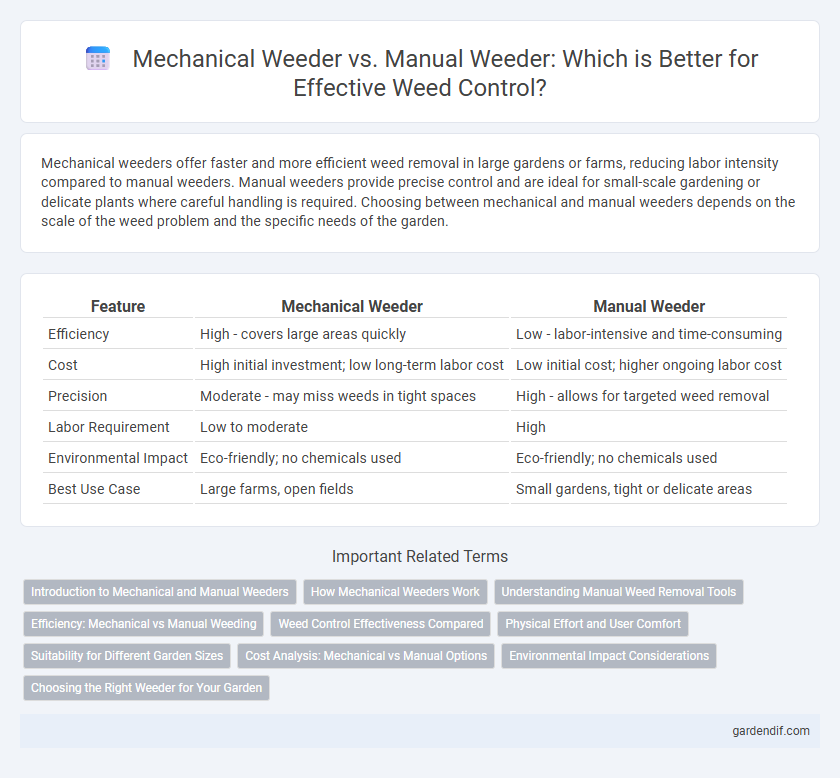
Mechanical weeder vs Manual weeder Illustration
Mechanical weeders offer faster and more efficient weed removal in large gardens or farms, reducing labor intensity compared to manual weeders. Manual weeders provide precise control and are ideal for small-scale gardening or delicate plants where careful handling is required. Choosing between mechanical and manual weeders depends on the scale of the weed problem and the specific needs of the garden.
Table of Comparison
| Feature | Mechanical Weeder | Manual Weeder |
|---|---|---|
| Efficiency | High - covers large areas quickly | Low - labor-intensive and time-consuming |
| Cost | High initial investment; low long-term labor cost | Low initial cost; higher ongoing labor cost |
| Precision | Moderate - may miss weeds in tight spaces | High - allows for targeted weed removal |
| Labor Requirement | Low to moderate | High |
| Environmental Impact | Eco-friendly; no chemicals used | Eco-friendly; no chemicals used |
| Best Use Case | Large farms, open fields | Small gardens, tight or delicate areas |
Introduction to Mechanical and Manual Weeders
Mechanical weeders employ advanced machinery to efficiently remove weeds, reducing labor intensity and increasing coverage area in agricultural fields. Manual weeders rely on handheld tools, offering precise weed removal but requiring more time and physical effort. Both methods play crucial roles in integrated weed management, balancing efficiency with selectivity.
How Mechanical Weeders Work
Mechanical weeders operate by using rotating blades or tines that disturb the soil surface to uproot or sever weed roots, effectively preventing their growth without damaging crops. These devices are powered by engines or tractors, offering consistent and efficient weed removal over large agricultural areas. By adjusting blade depth and speed, mechanical weeders target weeds at early growth stages, optimizing weed control and promoting healthier crop yields.
Understanding Manual Weed Removal Tools
Manual weed removal tools such as hoes, hand weeders, and garden forks provide precise control for targeting individual weeds, minimizing damage to surrounding plants and soil. These tools are effective for small to medium-sized gardens where selective removal is critical, and they promote soil aeration during use. Mechanical weeders, while efficient for large areas, lack the accuracy and adaptability that manual tools offer for specific weed management needs.
Efficiency: Mechanical vs Manual Weeding
Mechanical weeders significantly increase efficiency by covering larger areas in less time compared to manual weeding, which is labor-intensive and slower. Advanced mechanical weeders utilize precise cutting or uprooting mechanisms that reduce crop damage and improve weed control consistency. Manual weeding remains effective in small-scale or delicate crop environments but lacks the speed and scalability needed for extensive agricultural operations.
Weed Control Effectiveness Compared
Mechanical weeders disrupt weed growth by uprooting or cutting weeds efficiently across large fields, leading to consistent weed control compared to manual methods. Manual weeders provide precise removal but are labor-intensive and less effective in maintaining widespread weed suppression. Studies indicate mechanical weeding reduces weed biomass by up to 70%, whereas manual weeding typically achieves 50-60% control, making mechanical weeders more suitable for large-scale operations.
Physical Effort and User Comfort
Mechanical weeders significantly reduce physical effort by automating the removal process, resulting in less strain on the user's back and hands compared to manual weeders. Manual weeders demand continuous bending, hand gripping, and repetitive motions, which can cause fatigue and discomfort over extended periods. Ergonomic designs in some mechanical weeders enhance user comfort by minimizing the need for strenuous physical activity while increasing efficiency.
Suitability for Different Garden Sizes
Mechanical weeders are highly suitable for large gardens and agricultural fields due to their efficiency in covering extensive areas quickly and reducing labor time. Manual weeders work best in small to medium-sized gardens where precision and careful handling of plants are essential to avoid damage. Gardeners managing mixed or delicate crops often prefer manual weeding for targeted control, while mechanical weeders excel in uniform, large-scale weed removal.
Cost Analysis: Mechanical vs Manual Options
Mechanical weeders require a higher initial investment, typically ranging from $200 to $1,500 depending on the model and capacity, but they significantly reduce labor costs over time. Manual weeders cost less upfront, often under $50, but demand considerable labor hours, translating to higher ongoing expenses for larger areas. Evaluating total cost of ownership, mechanical options prove more economical for extensive farming, while manual weeders remain viable for small-scale or low-budget operations.
Environmental Impact Considerations
Mechanical weeders significantly reduce chemical herbicide usage, lowering soil and water contamination compared to manual weeding. They promote soil aeration while minimizing labor intensity, but may increase fossil fuel consumption if not powered by renewable energy. Manual weeding avoids machinery emissions, supporting organic farming practices, yet it demands intensive labor and can lead to soil compaction from repeated human activity.
Choosing the Right Weeder for Your Garden
Mechanical weeders offer efficient soil cultivation and faster weed removal, ideal for larger gardens and reducing physical strain. Manual weeders provide precision and control, making them suitable for delicate plants and small-scale gardening. Assess garden size, plant type, and personal physical capacity to select the most effective weeder for your specific needs.
Mechanical weeder vs Manual weeder Infographic

 gardendif.com
gardendif.com